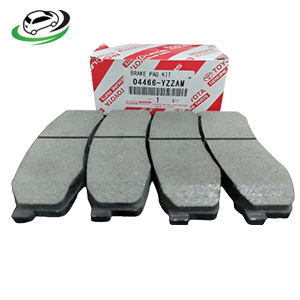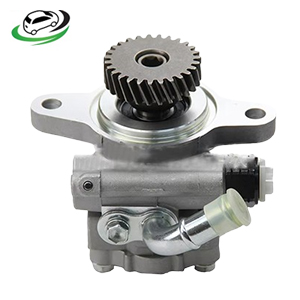-10%
Get Power Steering Pump 44310-60420 Fit For Toyota Land Cruiser 2HDJ100 HDJ101 1HDFTE 4013060420 4430420 SP81441 PA1631
A power steering pump is a crucial component of a vehicle’s power steering system, responsible for facilitating easier steering by providing hydraulic pressure to the steering mechanism. It ensures that the driver can turn the steering wheel with minimal effort, enhancing maneuverability and control, especially at low speeds or when the vehicle is stationary.
Function and Importance
The primary function of the power steering pump is to supply hydraulic fluid to the power steering system at a specific pressure. When the driver turns the steering wheel, the power steering pump directs the hydraulic fluid to the steering gear, providing the necessary force to turn the wheels. This hydraulic assistance significantly reduces the physical effort required by the driver, especially at low speeds or during parking maneuvers.
Components of a Power Steering Pump
A typical power steering pump consists of several key components:
- Housing: This is the outer shell that encases the pump mechanism.
- Rotor and Vanes: The rotor, mounted inside the housing, spins as the engine runs. Attached vanes within the rotor help to create chambers for hydraulic fluid.
- Inlet and Outlet Ports: These ports allow hydraulic fluid to enter and exit the pump.
- Pressure Relief Valve: This valve regulates the maximum pressure to ensure the system operates within safe limits.
- Pulley: Connected to the engine via a belt, the pulley drives the pump’s rotor.
Types of Power Steering Pumps
There are various types of power steering pumps, each with its unique features and mechanisms:
- Vane Pump: This is the most common type, using vanes within a rotor to generate hydraulic pressure.
- Roller Pump: Uses rollers instead of vanes, providing smooth and consistent pressure.
- Gear Pump: Utilizes gears to move the hydraulic fluid, often found in older or heavy-duty vehicles.
Benefits of a Power Steering Pump
1. Enhanced Steering Ease
One of the primary benefits of a power steering pump is the reduction in the physical effort required to steer the vehicle. This ease of steering is particularly noticeable at low speeds or when the vehicle is stationary.
- Reduced Driver Fatigue: By assisting the steering mechanism, the pump allows drivers to steer with minimal effort, preventing fatigue, especially during long drives or in heavy traffic.
- Effortless Maneuverability: Navigating tight spaces, parking, and making sharp turns become much easier, improving overall maneuverability.
2. Improved Safety
A power steering pump contributes to vehicle safety in several ways:
- Enhanced Control: It enables more precise and responsive steering, allowing drivers to maintain better control over the vehicle.
- Quick Steering Adjustments: In emergency situations, the assisted steering allows for quicker and more accurate steering adjustments, which can be crucial in avoiding collisions or navigating obstacles.
- Stability at High Speeds: The system helps maintain steering stability and control at higher speeds, reducing the risk of oversteering or understeering.
3. Increased Comfort
The power steering pump significantly enhances driving comfort by providing a smoother and more consistent steering experience.
- Smooth Steering Feel: The hydraulic assistance smooths out the steering feel, eliminating the jarring sensation that can occur with manual steering systems.
- Noise Reduction: Modern power steering systems are designed to operate quietly, reducing noise and vibrations that could otherwise contribute to driver discomfort.
4. Versatility in Design
Power steering pumps are versatile and adaptable to various vehicle designs and configurations, offering benefits across a range of vehicle types.
- Compatibility: They are used in everything from compact cars to large trucks, ensuring that vehicles of all sizes benefit from easier steering.
- Customization: Power steering systems can be fine-tuned for different driving conditions and preferences, such as providing more assistance at low speeds and less at high speeds.
5. Extended Component Life
Properly functioning power steering pumps contribute to the longevity of other steering components by reducing the strain and wear on them.
- Reduced Wear: By assisting the steering effort, the pump minimizes the mechanical stress on the steering gear and related components, potentially extending their lifespan.
- Consistent Performance: The hydraulic pressure provided by the pump ensures consistent performance of the steering system, preventing irregularities that could lead to premature wear.
6. Technological Integration
Modern power steering pumps integrate seamlessly with advanced automotive technologies, enhancing overall vehicle functionality.
- ADAS Integration: Advanced Driver Assistance Systems (ADAS) such as lane-keeping assist and automated parking often rely on power-assisted steering for precise control.
- Fuel Efficiency: Newer power steering pumps are designed to be more efficient, reducing the overall load on the engine and contributing to better fuel economy.
7. Maintenance and Reliability
While power steering pumps require some maintenance, their benefits in terms of reliability and ease of service are notable.
- Simplified Maintenance: Regular checks and fluid replacements can keep the power steering system in good condition, ensuring reliable performance.
- Diagnostic Capabilities: Modern vehicles often include diagnostic systems that can detect issues with the power steering pump early, allowing for timely repairs and preventing more significant problems.
Signs of a worn out power steering pump:
1. Whining or Groaning Noises
One of the most common signs of a failing power steering pump is unusual noises coming from the pump, especially when turning the steering wheel.
- Whining Noise: Often indicates low power steering fluid levels or air trapped in the system. This noise usually becomes more pronounced when the steering wheel is turned.
- Groaning or Squealing Noise: Can signal a more severe problem with the pump or a worn-out belt.
2. Stiff or Difficult Steering
If the power steering pump is failing, you might notice increased difficulty in turning the steering wheel, especially at low speeds or when the vehicle is stationary.
- Hard Steering: Indicates that the pump is not providing enough hydraulic pressure to assist with steering.
- Intermittent Steering Assist: Steering might alternate between normal and difficult, indicating inconsistent pump performance.
3. Leaking Power Steering Fluid
Power steering fluid leaks are a clear sign that there’s a problem within the power steering system.
- Puddles Under the Car: If you notice puddles of reddish or brownish fluid under your vehicle, it could be leaking power steering fluid.
- Low Fluid Levels: Consistently low fluid levels in the reservoir can indicate a leak somewhere in the system.
4. Foam or Bubbles in the Power Steering Fluid
When inspecting the power steering fluid, the presence of foam or bubbles can indicate air entering the system.
- Aerated Fluid: Air in the fluid can reduce the effectiveness of the hydraulic system and cause noise and vibration.
- Fluid Color Change: The fluid may appear frothy or lighter in color than usual.
5. Delayed Response or Slow Steering
A failing power steering pump may result in a noticeable delay in the vehicle’s response to steering inputs.
- Slow Steering Response: There might be a lag between turning the steering wheel and the vehicle’s wheels responding.
- Uneven Steering: The steering might feel uneven or jerky as the hydraulic pressure fluctuates.
6. Warning Light on the Dashboard
Modern vehicles are equipped with sensors that monitor the power steering system.
- Steering System Warning Light: If the power steering system warning light illuminates, it can indicate a problem with the power steering pump or related components.
- Check Engine Light: In some cases, issues with the power steering pump can trigger the check engine light.
7. Burning Smell
A failing power steering pump can cause a burning smell due to overheating or friction.
- Overheating Pump: Excessive friction within the pump can cause it to overheat and emit a burning odor.
- Leaking Fluid on Hot Engine Parts: Power steering fluid leaking onto hot engine parts can also produce a burning smell.
8. Visible Damage or Wear
Physical inspection of the power steering pump and its components can reveal signs of wear or damage.
- Cracked or Frayed Belts: The belt driving the power steering pump may show signs of wear or damage.
- Corrosion or Damage: Visible corrosion, cracks, or other damage on the pump itself can indicate a problem.
Follow us on Facebook for more parts.





